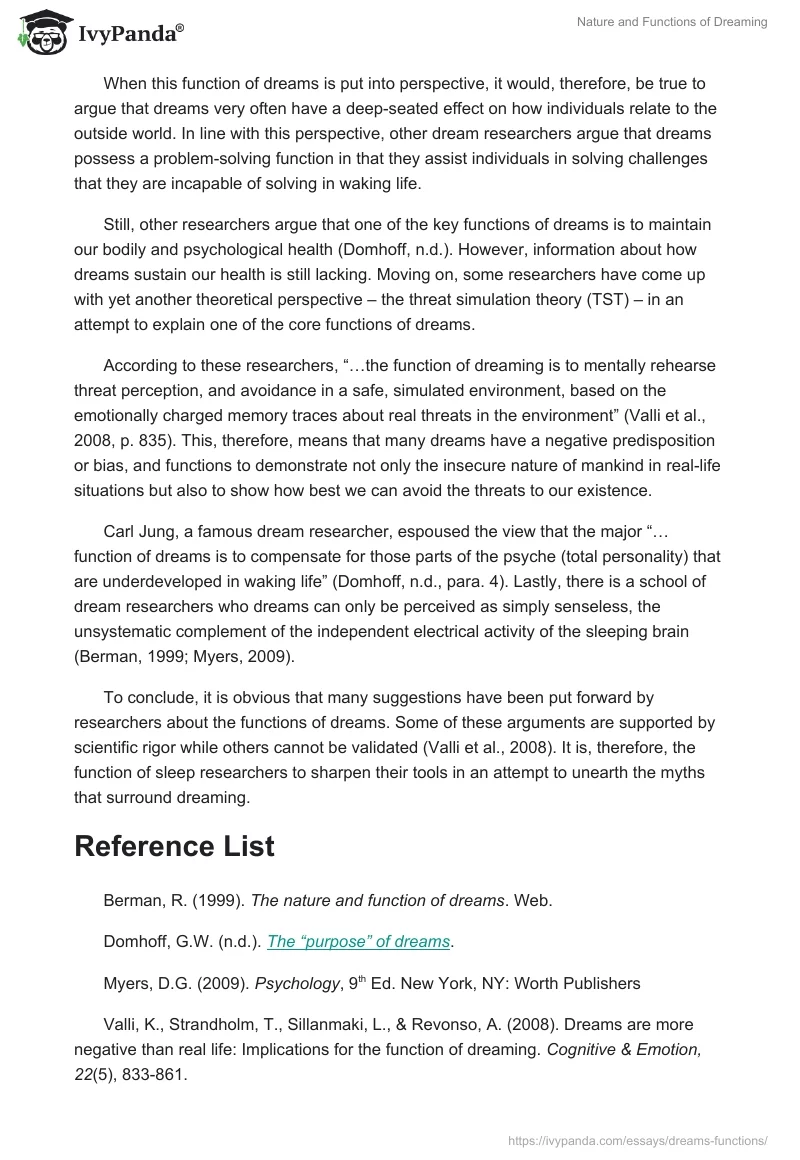From prehistoric times to the present day, dreams have intrigued mankind across all civilizations. Dream researchers have over the years attempted to front various propositions about why humans engage in these ‘mystic’ processes and their real or perceived functions in life, but consensus on the outcomes of their studies has so far remained as elusive as ever.
However, there has been a broad concurrence among the researchers that emotional memories are triggered during the process of dreaming and that emotions play a domineering part in the thematic development of the dream (Valli et al., 2008; Myers, 2009). This paper purposes of evaluating some of the functions researchers think dreams serve today.
Researchers concur that 80 percent of dreams occur during the sleep phase known as ‘Rapid Eye Movement’ or simply REM as this is the phase when consolidation of emotional memories becomes more enhanced (Valli et al., 2008; Myers, 2009).
Although Sigmund Freud didn’t have this knowledge beforehand when he constructed his notions about dreams, the Austrian neurologist projected a psychoanalytic disposition to argue that the main “…function of dreams was to allow the release of repressed thoughts and impulses which cause excitation and neural activity” (Berman, 1999, para. 8).
Freud argued that every dream has an explicit significance which is carried in the form of a message manifested by unconscious processes. The content of the dream, according to Freud, is a symbol for some camouflaged, or rather suppressed wish of the consciousness and therefore individuals must reason backward in a process known as ‘free association’ for them to interpret the real meaning of their dreams (Berman, 1999).
Freud was also of the opinion that dreams functioned to preserve sleep. Another view projected by researchers such as Vygotsky and Lacan suggests that the main function of dreams is to fulfill a specific human need that attributes a cause to the things that we experience within the environment daily (Valli et al., 2008).
When this function of dreams is put into perspective, it would, therefore, be true to argue that dreams very often have a deep-seated effect on how individuals relate to the outside world. In line with this perspective, other dream researchers argue that dreams possess a problem-solving function in that they assist individuals in solving challenges that they are incapable of solving in waking life.
Still, other researchers argue that one of the key functions of dreams is to maintain our bodily and psychological health (Domhoff, n.d.). However, information about how dreams sustain our health is still lacking. Moving on, some researchers have come up with yet another theoretical perspective – the threat simulation theory (TST) – in an attempt to explain one of the core functions of dreams.
According to these researchers, “…the function of dreaming is to mentally rehearse threat perception, and avoidance in a safe, simulated environment, based on the emotionally charged memory traces about real threats in the environment” (Valli et al., 2008, p. 835). This, therefore, means that many dreams have a negative predisposition or bias, and functions to demonstrate not only the insecure nature of mankind in real-life situations but also to show how best we can avoid the threats to our existence.
Carl Jung, a famous dream researcher, espoused the view that the major “…function of dreams is to compensate for those parts of the psyche (total personality) that are underdeveloped in waking life” (Domhoff, n.d., para. 4). Lastly, there is a school of dream researchers who dreams can only be perceived as simply senseless, the unsystematic complement of the independent electrical activity of the sleeping brain (Berman, 1999; Myers, 2009).
To conclude, it is obvious that many suggestions have been put forward by researchers about the functions of dreams. Some of these arguments are supported by scientific rigor while others cannot be validated (Valli et al., 2008). It is, therefore, the function of sleep researchers to sharpen their tools in an attempt to unearth the myths that surround dreaming.
Reference List
Berman, R. (1999). The nature and function of dreams. Web.
Domhoff, G.W. (n.d.). The “purpose” of dreams.
Myers, D.G. (2009). Psychology, 9th Ed. New York, NY: Worth Publishers
Valli, K., Strandholm, T., Sillanmaki, L., & Revonso, A. (2008). Dreams are more negative than real life: Implications for the function of dreaming. Cognitive & Emotion, 22(5), 833-861.


